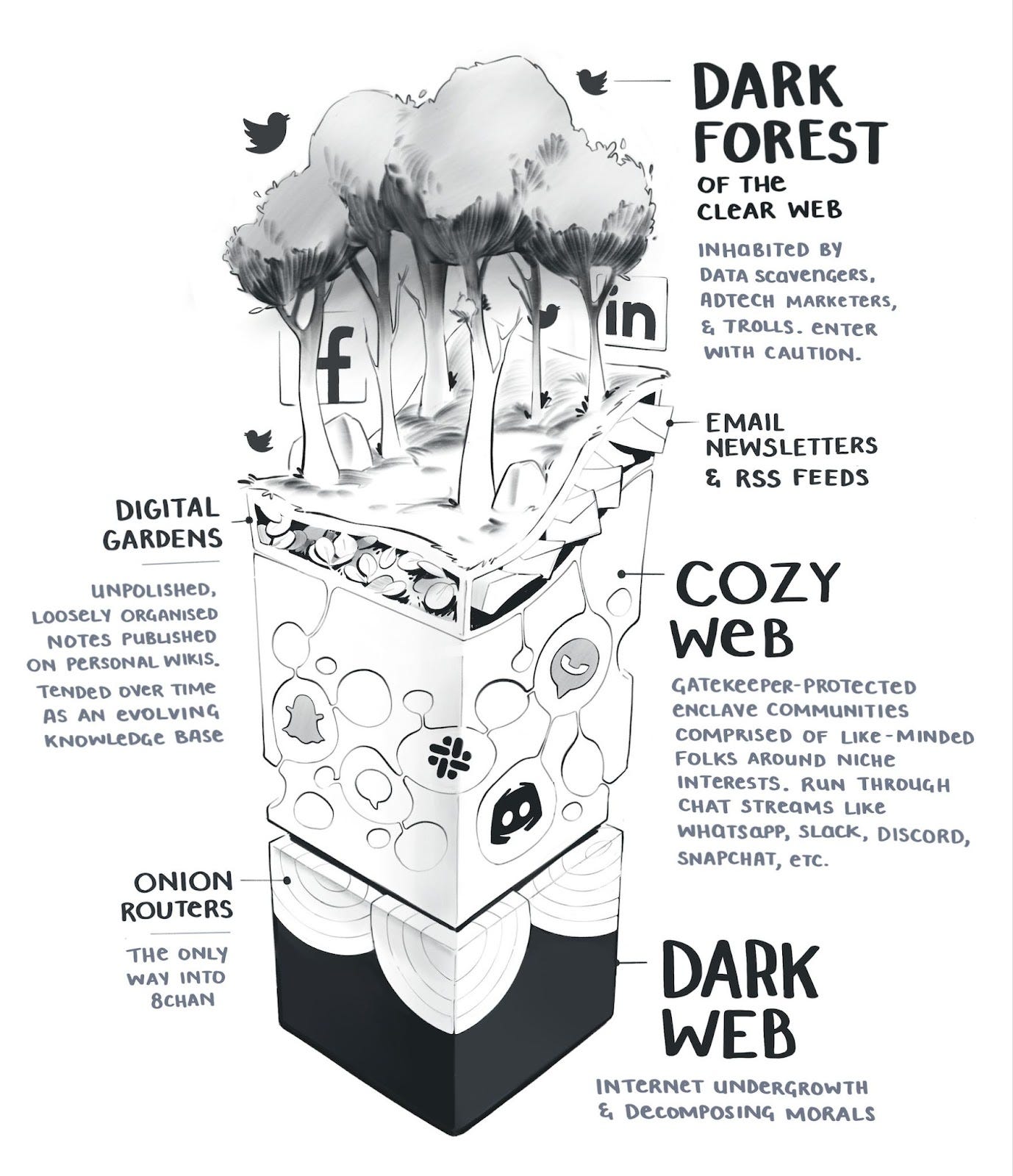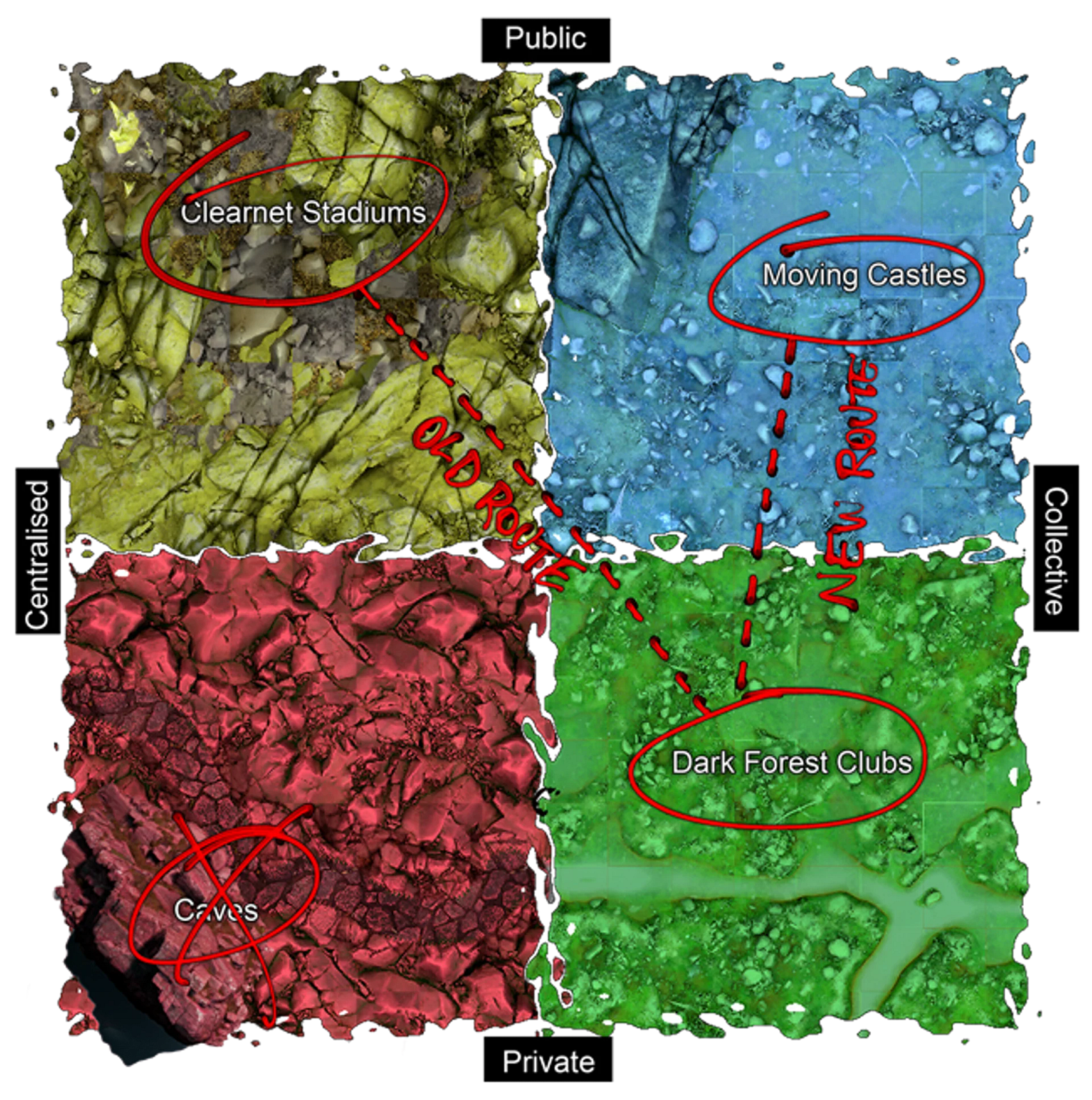The Metalanguage of the Internet
The Dark Forest Collective has published a book titled The Dark Forest Anthology, which is available for purchase through
. This anthology features the who’s who of intellectual hipsters providing meta takes on the internet: , , , , , , etc. and I contributed a piece to the anthology titled “Chapel Perilous,” a figurative retelling of the "dark forest" that is The Stoa.When I sense the throughline between the individuals within this Collective, the commonality seems to be creating a “metalanguage of the internet.” A “metalanguage” is a language about a language, or “object language,” pointing out the norms that make the language work. The individuals in the Collective are all creating or using terms that make sense of the internet in a way that goes beyond market dynamics, sensing its humane potential while helping others navigate its current platforms.
I’ll provide a glossary for this metalanguage. These terms, many of which can be read about in The Dark Forest Anthology, have personally helped me navigate being online and avoid or overcome many of the failure modes that seem to plague other “content creators,” such as creator burnout, audience capture, and parasocial trauma bonding (aka culture warring).
The terms:
Community-as-Media
Cozyweb
Creator Stadiums
Dark Forests
Digital Campfires
Digital Gardens
Memetic Tribes
Moving Castles
Platform Physics
Platform Wars
Proof of Vibes
Protocol Pill
Second Self
Community-as-Media
Coiners: Carolina Busta and Lil Internet
An online community is seen as a trusted source of truth, where truth claims are disseminated, attracting new members.
From “Holographic Media”:
To understand what this new era of community as media looks like, imagine the Web 1.0 webforum—multiple nodes arranged in a circle, each equally connected to the others. Now imagine the Web 2.0 attention-driven network: a sea of individual influencers connected unidirectionally to tiers of followers. In a composable community-as-media model, a protocol synthesizes both. Members of a shared network interact in a non-gamified, horizontal way—as in webforums—while also broadcasting across social media feeds, cross-pollinating their community’s thoughts and attracting new members.
From a conversation I had with Caroline and Lil Internet:
Cozyweb
Coiner: Venkatesh Rao
Private online spaces that are established and maintained by bespoke protocols.
From “The Extended Internet Universe”:
Unlike the main public internet, which runs on the (human) protocol of “users” clicking on links on public pages/apps maintained by “publishers”, the cozyweb works on the (human) protocol of everybody cutting-and-pasting bits of text, images, URLs, and screenshots across live streams. Much of this content is poorly addressable, poorly searchable, and very vulnerable to bitrot. It lives in a high-gatekeeping slum-like space comprising slacks, messaging apps, private groups, storage services like dropbox, and of course, email.
Creator Stadiums
Coiners: Arthur Roing Bear and GVN908
Places where creators broadcast their content, backed by their supporters.
From “Modular and Portable Multiplayer Miniverses”:
Currently, many semi-private communities that rely on crowdfunding to finance their activities also use the public media formats of the creator economy, or Clearnet Stadiums; a vast array of podcasts, private newsletters and video-essays built to highlight individual sensibilities and passions. Creator Stadiums give expression to the thoughts and knowledge of the content-creators that use them to communicate with potential and already existing audiences.
Dark Forests
Coiner: Yancey Strickler (current understanding)
Online gathering spaces that are hidden from public view.
From “The Dark Forest Theory Of The Internet”:
This is also what the internet is becoming: a dark forest. In response to the ads, the tracking, the trolling, the hype, and other predatory behaviors, we’re retreating to our dark forests of the internet, and away from the mainstream.
Digital Campfires
Coiner: Sara Wilson
Spaces for conversation and experience emerging within the dark forests.
From “The Era of Antisocial Social Media”:
If social media can feel like a crowded airport terminal where everyone is allowed, but no one feels particularly excited to be there, digital campfires offer a more intimate oasis where smaller groups of people are excited to gather around shared interests. I’ve identified three categories of digital campfires: private messaging, micro-communities, and shared experiences. Some digital campfires are a combination of all three.
Digital Gardens
Coiner: Maggie Appleton (current understanding)
A method of arranging information online based on contextual connections for personal navigation.
From “A Brief History & Ethos of the Digital Garden”:
A garden is a collection of evolving ideas that aren't strictly organised by their publication date. They're inherently exploratory – notes are linked through contextual associations. They aren't refined or complete - notes are published as half-finished thoughts that will grow and evolve over time. They're less rigid, less performative, and less perfect than the personal websites we're used to seeing.
Memetic Tribes
Coiners: Peter Limberg and
People and bots that act and appear tribal around a memeplex (a meme complex).
From “Memetic Tribes and Culture War 2.0”:
We define a memetic tribe as a group of agents with a meme complex, or memeplex, that directly or indirectly seeks to impose its distinct map of reality — along with its moral imperatives — on others. These tribes are on active duty in the new culture war. They possess a multiplicity of competing claims, interests, goals, and organizations. While the red and blue tribes were certainly far from monolithic, any claim to unity between memetic tribes is laughable.”

Moving Castles
Coiners: Arthur Roing Bear and GVN908
Online communities with movable “miniverses” (contrasted to “metaverse”), agile worlds with their own lores, protocols, and economies.
From “Modular and Portable Multiplayer Miniverses”:
A Moving Castle—as popularised by Studio Ghibli’s cult movie “Howl’s Moving Castle”, based on Diana Wynne Jones’ 1986 book of the same title—is a nomadic patchwork of different spaces of mutating and incoherent scale. Such spaces are “bespelled to hold together’’ by the will of their inhabitants, which the Moving Castle can transport to different worlds in times of needs or wish.
Platform Physics
Coiners: Carolina Busta and Lil Internet
The design of a medium dictates how content moves within a network.
From “Holographic Media”:
Platform physics are the ways in which a medium’s design determines a piece of content’s nature, the content’s “natural motion” through a network, its recipients’ responses, and the various nth order effects of this content being in circulation.
From a conversation I had with Caroline and Lil Internet:
Platform Wars
Coiner: Joshua Citarella
Social media platforms vie for data and users by impeding content portability across platforms.
From “The Platform Wars”:
All platforms have deployed nearly identical tools: $5 rolling subscriptions, live-streaming, long form posts for premium users, private chats, vertical video shorts, and more. In the short term, platforms will compete on the level of culture (ie which sites have the best offerings for content). In the long term, they will compete on the level of network effects, towards the end goal of establishing an everything-app monopoly. Whether it be Elon Musk’s new X app, Meta, or something else entirely, eventually a quasi-state American analog to WeChat will arise.
Proof of Vibes
Coiner: Leïth Benkhedda (current understanding)
A security mechanism discerning group membership based on a group's ever-evolving sense of vibes.
From “Proof of Vibes”:
In “Squad Wealth,”
define vibes as “the ineffable energy that the squad values most” and “an unstable substance of high information density.” Online communities, very much like their IRL counterpart, do operate on “vibes.” Vibes always be shifting, and for those who do not live in the pod and do not eat the bugs, virtual community lore moves much faster than one can keep track of.
Protocol Pill
Coiner: Summer of Protocols
To bring awareness to the importance of having protocol literacy.
From “The Unreasonable Sufficiency of Protocols”:
A protocol is a relatively simple and codified set of behaviors that, when adopted by a sufficient number of participants (human and/or artificial) in a situation, reliably leads to good-enough outcomes for all.
Second Self
Coiner: Sherry Turkle
One’s digital persona across the internet, consciously or unconsciously shaped by an individual, audience, or memetic tribe.
From The Second Self: Computers and the Human Spirit:
Further, the psychological holding power of the computer is no longer limited to one-on-one person/machine interaction. Millions of people now interact with one another via computers on networks, where they have the opportunity to talk, to exchange ideas and feelings, and to assume personae of their own creation
***
While I often critique various aspects of online culture, predominantly highlighting the negative, the internet can be viewed as a remarkable blessing. Stewarding The Stoa has acquainted me with wonderful individuals who have enriched my life in myriad ways. With the help of the Collective making sense of the internet, I know we can connect online in ways that transcend the incentives current online platforms entice us with.
All of the above terms can be seen as “performative utterances,” speech acts that not only describe reality, but shapes the reality it describes. I perceive that the reality shaped by these terms suggests a move towards a more humane internet, as conveyed by expressions like forests, campfires, and gardens. Such terms provide a wholesome sense of agency in navigating the internet as it exists toward its potential evolution.
I am optimistic that humane ways of being online are emerging. The internet is not what we think it is. It is what we collectively make it.
I want to extend personal gratitude to Yancey for cohering the Collective and creating a book that we can all take pride in, which also serves as a great starting point to understand what the internet can become. There are 777 available copies of the first edition, which, upon purchase, will include a digital copy and a round table with the Collective. I hope all wisdom commoners can obtain a copy.
If you're interested in a preview of the “Chapel Perilous” piece from the anthology, Rebecca and I have recorded a video that offers some theoretical context.







